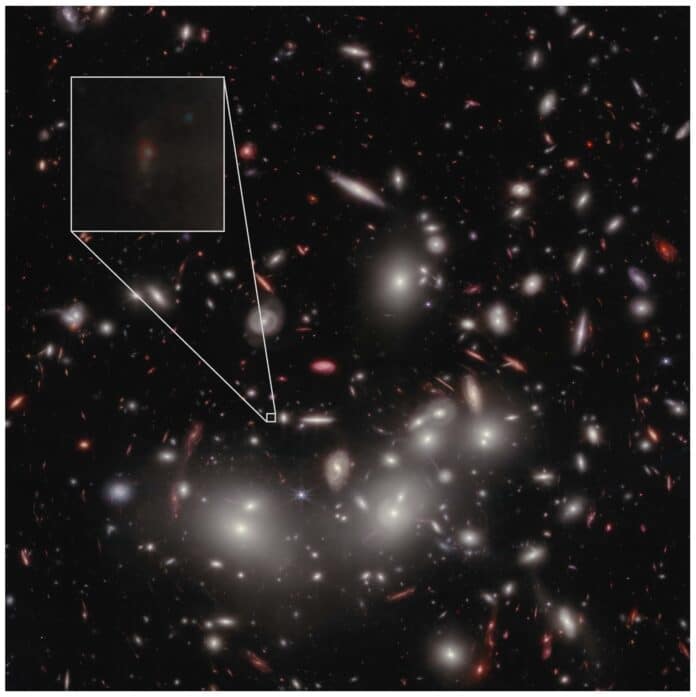In the first billion years after the Big Bang, sources of ultraviolet (UV) photons are believed to have ionized intergalactic hydrogen, rendering the Universe transparent to UV radiation. Fainter galaxies are thought to dominate the photon budget; however, they are surrounded by neutral gas that prevents the escape of the Lyman-α photons, which has been the dominant way to identify them so far.
The existence of the faintest galaxy ever observed in the early cosmos has been confirmed by an international research team headed by UCLA astrophysicists. The galaxy known as JD1 is one of the farthest galaxies discovered. It is a representative example of the types of galaxies that blazed through the hydrogen atom cloud left over after the Big Bang, allowing light to shine through the Universe and forming it into what it is today.
JD1 is only possible to observe with a powerful telescope and some assistance from nature because it is so dim and distant. The light from JD1 is amplified and bent by the gravitational influence of a huge group of nearby galaxies named Abell 2744, making JD1 look larger and 13 times brighter than it is. Without gravitational lensing, JD1 would have gone unnoticed; the effect is comparable to how a magnifying glass distorts and amplifies light inside its field of view.
Guido Roberts-Borsani, a UCLA postdoctoral researcher and the study’s first author, said, “Most of the galaxies found with JWST so far are bright galaxies that are rare and not thought to be particularly representative of the young galaxies that populated the early Universe. As such, while important, they are not thought to be the main agents that burned through all of that hydrogen fog.”
“Ultra-faint galaxies such as JD1, on the other hand, are far more numerous, which is why we believe they are more representative of the galaxies that conducted the reionization process, allowing ultraviolet light to travel unimpeded through space and time.”
The scientists were able to determine the galaxy’s precise age and distance from Earth, as well as the number of stars, amount of dust, and heavy elements that it formed in its relatively brief lifetime, thanks to the Webb Telescope’s near-infrared spectrograph instrument, NIRSpec.
The team studied the galaxy’s structure in unprecedented detail and resolution thanks to the gravitational magnification of the galaxy and fresh images from NIRCam, another near-infrared instrument on the Webb Telescope. This analysis revealed three main elongated dust and gas clumps forming stars. With the aid of the fresh information, the team was able to determine the origin and shape of JD1’s light and identify a small galaxy that is only a small portion of the size of older galaxies like the Milky Way, which is 13.6 billion years old.
Tommaso Treu, a UCLA physics and astronomy professor and the study’s second author, said, “Before the Webb telescope switched on just a year ago, we could not even dream of confirming such a faint galaxy. The combination of JWST and the magnifying power of gravitational lensing is a revolution. We are rewriting the book on how galaxies formed and evolved in the immediate aftermath of the Big Bang.”
Journal Reference:
- Roberts-Borsani, G., Treu, T., Chen, W. et al. The nature of an ultra-faint galaxy in the cosmic dark ages is seen with JWST. Nature (2023). DOI: 10.1038/s41586-023-05994-w
